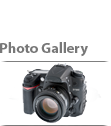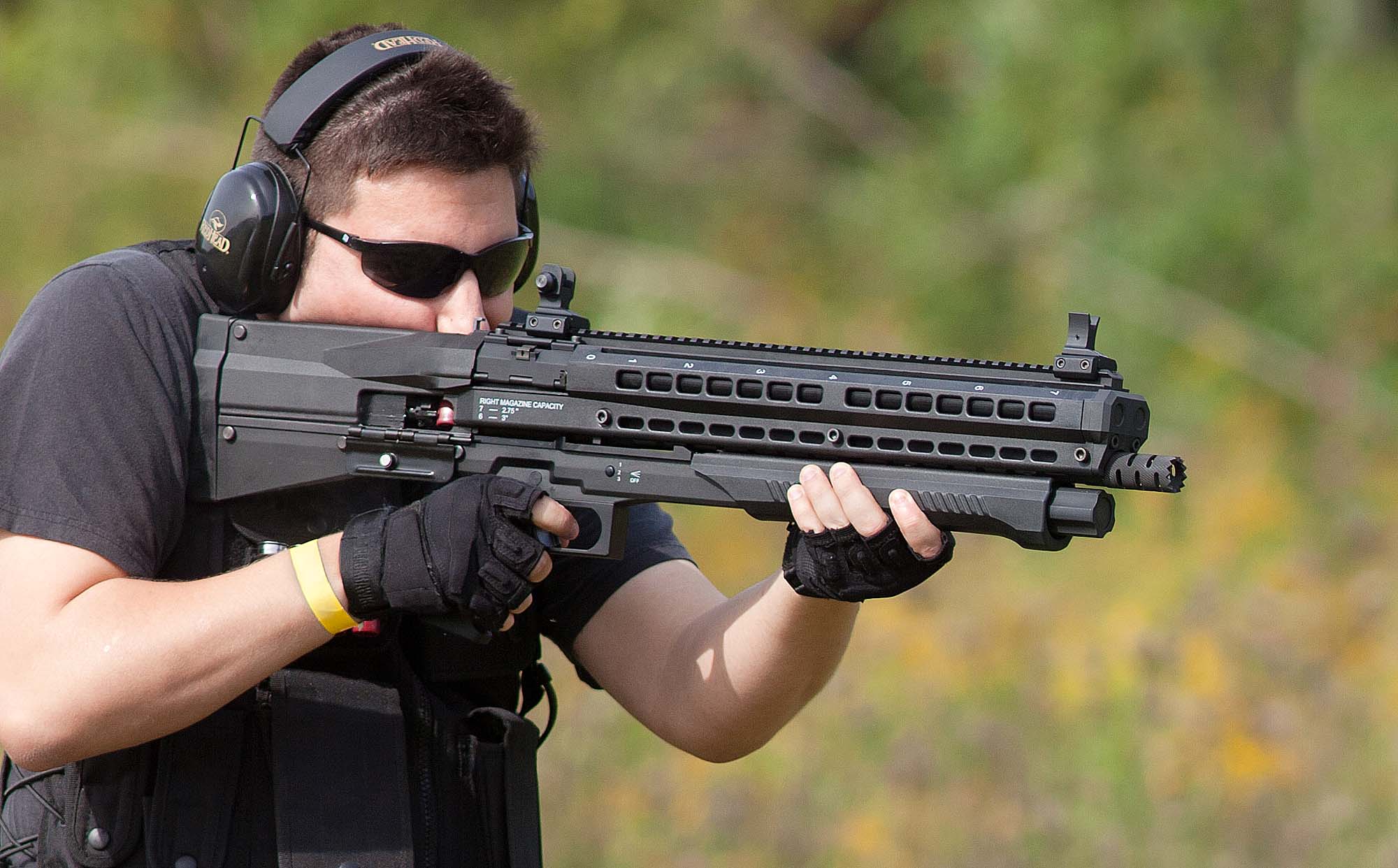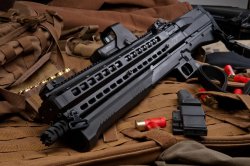
So far, the products of this Turkish company are not all that well known in Europe. Instead, in the United States, where they are marketed with local importers’ brand, they were awarded “Gun of the Year” by the NRA on two different occasions, in 2006 and 2007. UTAS, with headquarters in Anatolia, manufactures airguns and shotguns (local law forbids the manufacture of rifles by private companies, unless a special authorization is provided), and is a shining example of how the modern Turkish firearms industry, in general, is one of the most dynamic and prolific, second for price competitiveness and attractiveness only to China, but far superior to it in product quality, which often have little or nothing to envy from European and American most renowned counterparts. In the second half of 2011, UTAS introduced a new shotgun to be launched on the market during the new year, a product that promises to become a real “must” for home and property defense, for law enforcement, for “pump” shooting sports and for... Hollywood filmmakers, contending a deserved share of the movie market with the better-known Striker-12, Truvelo Neostead or Kel-Tec KSG. This is the UTS-15: “Urban Tactical Shotgun”.
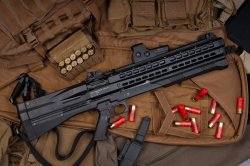
Despite its Turkish origins, the history of the UTS-15 began in the United States, specifically in 2006. It is in fact in the U.S. that UTAS sells most of its products under the brand names of famous companies such as Kimber, Savage/Stevens and Smith&Wesson; it was the latter to decide, at the time, to expand into the tactical/operational shotgun sector by adopting an aggressive and unorthodox design (as was being done by many of its competitors) that could possibly make customers forget the fiasco of the previous adventures of the Springfield based company in the “pump action” market with the 916 and 3000 models, manufactured between 1970 and 1980 by the Japanese company Howa Machineries, and decidedly unloved by end users because of the inherent barrel weaknesses, very prone to breakage and explosion. Furthermore, in 2006 Smith&Wesson launched, under its own brand, two new shotgun ranges for hunting and shooting sports produced by UTAS: The semi-automatic 1000 model and the Elite juxtaposed barrel shotguns.
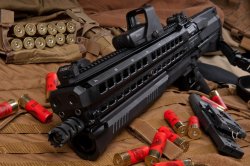
Smith&Wesson entrusted to an outside consultant, the famous American gunsmith Ted Hatfield, the project to create a new tactical shotgun, and wanted to rely on UTAS’ proven capacity to venture into a process of reverse engineering the known Neostead, a 12 caliber pump action shotgun produced in South Africa featuring a “semi-bull pup” design with reversed loading cycle and twin tubular magazines located above the barrel. Hatfield’s experience and lengthy series of tests at UTAS soon led to the decision to redesign the whole system keeping only the location of the magazines above the barrel, an intelligent solution to keep a certain amount of weight over a critical area and efficiently counteract the muzzle climb when firing, allowing the operator to “stay on target” and, if needed, to place a second shot faster on the target.
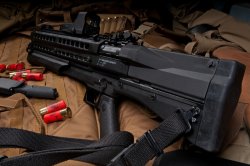
In 2008, however, because of financial problems mainly due to the commercial failure of the 1000 series shotguns, Smith&Wesson decided to abandon hopes of returning to the field of “pump action” operations and withdrew from the project. UTAS did not share this opinion: the American corporationʼs abandonment could not erase months of R&D, considerable economic investments already made and even some working prototypes already built. The project continued with the Turkish company coming to fruition in early 2011, in occasion of the IDEX defense exhibition of the same year. UTAS presented its new, authentic smooth bore “beast” that was ready to go into production in two factories, in Turkey and the United States.
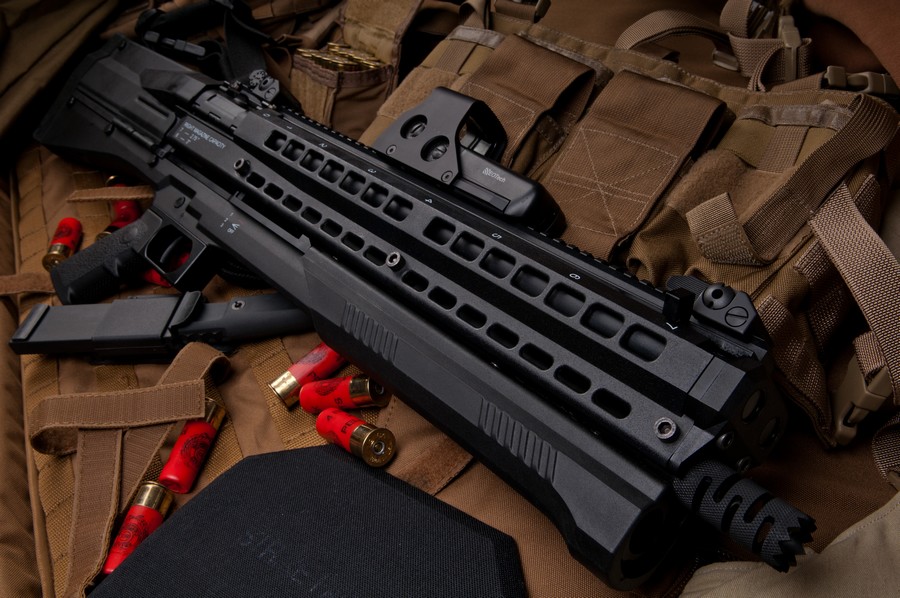
The UTS-15, as its name suggests, is a tactical shotgun specifically conceived for military and police operations on urban terrain, feeding through two side-by-side magazine tubes, each sporting a capacity of seven 12-gauge, 70mm (2-¾”) standard shotshells, or six 12-gauge, 76mm (3", "Magnum") shots. Allowing for an additional shell to be loadedin che chamber, it tops an impressive overall capacity of fifteen shots in 12-gauge "Standard" ammunition or thirteen shots in "Magnum" rounds! The UTS-15 semi-bullpup design is based upon a carbon fiber-reinforced polymer chassis that keeps weight under acceptable levels (less than 3 kg, empty). Metal is used only on internal, moving parts, as well as for the barrel, and all are manufactured in the United States by the Hatfield Gun Company, headquartered in Des Plaines (Illinois) and owned by Tom Hatfield, the designer of the UTS-15 himself who also handles assembly and distribution for the North American market.
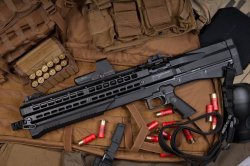
The UTS-15 features a standard manual-operated slide-action cycle, AKA a traditional “pump action”: the reinforced polymer forearm must be pulled rearwards until it reaches the end of its travel, then pushed again forward. In order to make the UTS-15 more “familiar” with American shooters, who are accustomed to the AR-15 system, the UTS-15 uses an AR15-style pistol grip, trigger and two-position switch located above the trigger guard, easily reached with the right hand thumb finger. The safety switch itself also features an additional safety latch function: through the use of a special tool, it can be set to make the UTS-15 completely inert and impossible to use. A great choice for those users who might need to store their gun away for long periods of time and thus might want to make it as much "theft-proof" as possible: without disengaging the latch through the proper tool, a thief or an otherwise unauthorized user will be unable to get the UTS-15 to work again.
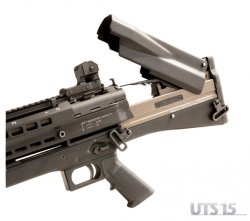
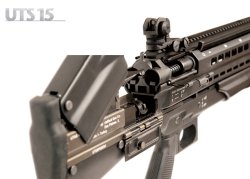
Two windows, placed on each side at the end of each magazine tube. allow the user to load the UTS-15 one shotshell at the time. Each magazine tube sports side windows with a moving cursor, activated by the pressure of the shotshells themselves inside the magazine, which will move rearwards every time that a shot is fired to point to a marked position on the receiver and provide the shooter with an immediately visible feedback on remaining ammunition. The breech box features a hinged cover lid which can be open to allow access to the entire breechbolt assembly and other moving parts for quick reload, field cleaning, maintenance or troubleshooting. The bolt on the UTS-15 is of the rotating type, and comes with three locking lugs that directly engage on the barrel extension; the stainless steel barrel is chromed and may be equipped with a machined flash hider and compensator that's been conceived for close-quarters combat and otherwise urban operation situations, so that shots may be fired point-blank at a target (e.g. for door breaching) without rising overpressure damage concerns. All spent cases are ejected from the right, through a single ejection window that's protected by an AR15-style, spring-loaded dust cover; The position of the ejection slot allows prompt right-handed or left-handed use.
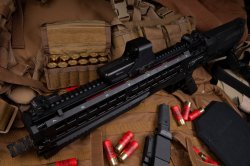
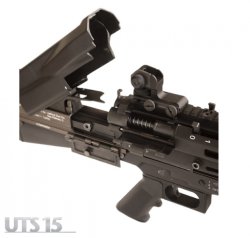
Like other twin ammunition tube shotguns (e.g. Kel-Tec KSG, Truvelo Neostead), the UTS-15 features a selection lever, located in a slot on the uppe receiver, right in front of the breechblock lid, to allow the shooter to select between three options: right tube, left tube, or alternate feeding from the left or the right, one shot at the time. This will allow military or Police personnel to load their shotgun with a mixture of ammo − both lethal and less-lethal, or buck shots and SABOTs, so to speak − and to select from time to time what kind of ammunition should they use according to his needs, thus allowing for true scalar use of force capabilities, not common on modern shotguns but much sought after by law enforcement professionals.
The UTS-15, however, stands above its two aforementioned most direct competitors by a feature that they lack: if the selector switch is set to feed the shotgun from a tube that's empty, simply "pumping" the shotgun will automatically move it so to allow the shooter to keep on firing the shells loaded in the remaining tube. This is a very important feature indeed, as during a crisis situation, like a high-intensity firefight, the shooter might not have the time, nor sometimes the brain, to fondle with the selector lever to change the feeding tube once one is empty; without such a feature, results may be catastrophic.
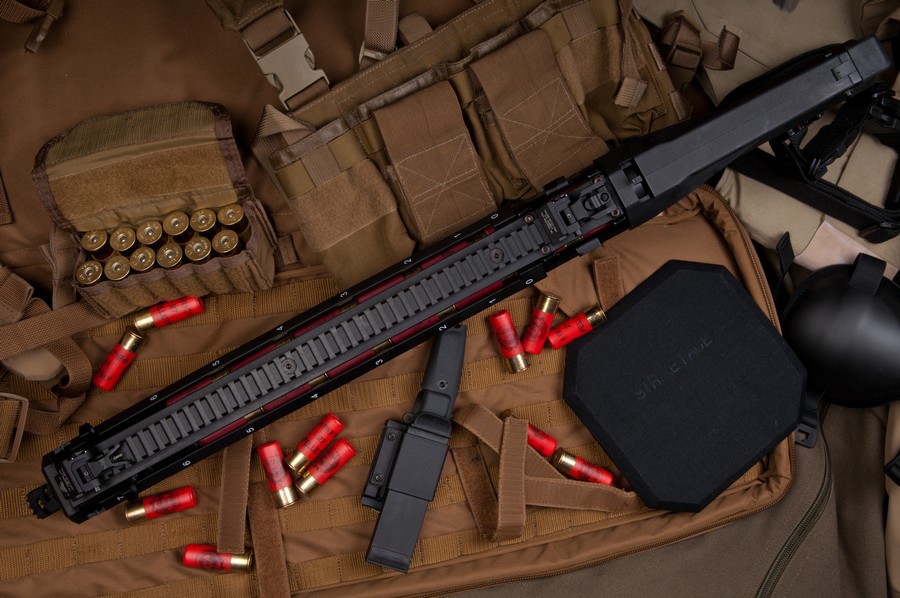
The UTS-15 lacks any form of integral sights; it comes instead with a MIL-STD-1913 "Picatinny" machined aluminium rail installed all along its upper receiver, allowing the shooter to mount any form of back-up iron sights or optical devices. Optional aftermarket rails can also be installed on the two sides of the gun through Allen screws the receiver is tapped for, and which also allow for the installation of sling attachment points. Moreover, a round slot located directly under the barrel will help the operator to quickly install a tactical flashlight or a laser/light accessory combo, whose remote controls can be placed on either side of the receiver; without this slot, the use of such a device may even require the installation of an additional Picatinny mounting point!
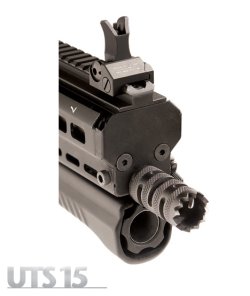
The first firing tests on the UTS-15 all resulted in positive feedbacks. Durable, strong and able to easily manage any kind of load with very low recoil levels, it is easy to “familiarize” with very quickly, even for those shooters who are not exactly acquainted with “exotic” weapons. The compact design allows for good maneuverability even in confined spaces (buildings, narrow passages, inside vehicles, etc.); the excellent balance and distribution of weights will allow shooters to hold it against the shoulder in the shooting position and to fire it single-handedly, using the weak hand to open doors, manage communication equipment and so on. The position of the loading slots improves quick loading even when the operator is moving, and last but not least, the main components of the UTS-15 can be rapidly and easily disassembled without use of any tools for cleaning in the field or routine maintenance. Finally, although all, or almost all, Bull-pup designs are necessarily equipped with a rather long trigger transfer bar, the trigger weight and length of pull are comparable with those of a good traditional “pump action” shotgun.
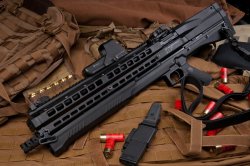
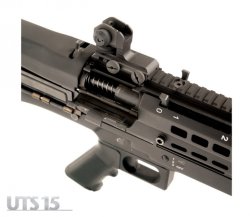
It is no coincidence that UTAS plans to launch a semiautomatic version of the UTS-15 and other types of weapons based on the same layout in the near future, in particular rifles and grenade launchers: it would seem that the design is a "winner" after all.
The weapon is going to be a success in the U.S. market: until recently, the entry of this type of weapon into the U.S. would have been out of the question, since the Federal Agency for the Control of Alcohol, Tobacco and Firearms (BATFE) had veto rights upon any smooth-bore weapon for sports use (“sporting purpose”) and thus could prohibit the importation or classify it as a “destructive device”, a category of weapons for which the possession needs the issuance of a government permit and the payment of a pretty heavy fee.
However, in November 2011, President Obama signed a law prohibiting BATFE to use federal funds for such practices, effectively ending the U.S. marketʼs import ban on most “tactical” 12-gauge shotguns.
Ever since then, the UTS-15 has been available on the U.S. market with a good commercial success. The UTS-15 is also available for commercial, civilian sales in Canada and in Europe, particularly in Italy.




